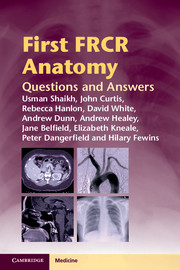Examination 3
Published online by Cambridge University Press: 05 March 2012
Summary
AP radiograph of the pelvis
Lesser trochanter of the right femur. The iliopsoas tendon attaches here. This is a powerful flexor of the hip.
Greater trochanter of the right femur. Gluteus medius and gluteus minimis attach here. These tendons act to perform hip abduction and lateral rotation. They can produce avulsion fractures of the greater trochanter in trauma.
Left L5 transverse process. The ilio-lumbar ligament attaches here. Traction of this ligament in pelvic trauma can cause an avulsion fracture of the transverse process. It also acts as an anatomical landmark on MRI for identifying the L5 vertebral body.
Pubic symphysis. It is a secondary cartilaginous joint.
Left inferior pubic ramus. Adductor magnus and adductor brevis attach here acting to adduct the hip.
Axial T2-weighted lumbar spine through L5
Left L5 nerve. At the level of the L5/S1 disc, the L5 nerve has already left the neural exit foramen. It may become compromised by a far lateral L5 disc herniation in this position.
Nucleus pulposus of L5/S1 disc. This soft central component of the disc is surrounded by the tough outer annulus fibrosus. Annular defects result in herniation of the nucleus pulposus referred to as protrusions or extrusions, based upon their morphology. On T2-weighted images the nucleus pulposus is of high signal and the annulus fibrosus is of low signal intensity.
Left lamina of L5 vertebra. Each lamina fuses in the midline to form the spinous process. The lamina is partly or completely resected (laminectomy) during lumbar disc surgery to facilitate access to the disc.
Right psoas major muscle. This is a powerful hip flexor. In the clinical setting of lumbar discitis it is common to see infection tracking from the disc space into the psoas muscle to form a psoas abscess.
Right S1 nerve.
- Type
- Chapter
- Information
- First FRCR AnatomyQuestions and Answers, pp. 78 - 84Publisher: Cambridge University PressPrint publication year: 2012



